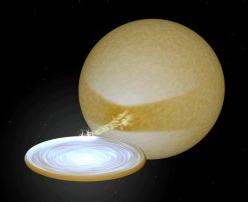Some Special Systems
 The Crab Pulsar
The Crab PulsarThe Supernova which created the Crab Nebula (and the Crab Pulsar) was observed in 1054 A.D. by Chinese Astronomers. These superb records enable us to carefully measure the evolution of this Supernova with time. Unique characteristics of the Crab Pulsar:
- It is among the youngest and thus fastest Pulsars, spinning 30 times a second.
- It is still so "hot" from the collapse, it shows an optical pulse (also see: here).
- The Crab Nebula has faded as it has expanded. It had been one of the brightest nebula in the sky back in 1774 and designated M1 in the first Messier Catalog.
 White Dwarfs & Pulsars in Binary systems
White Dwarfs & Pulsars in Binary systemsMost stars are born in binary systems. If a binary pair survives after the more massive star goes Supernova, we are left with a compact object (neutron star or black hole) in orbit around a normal star. Nova and Supernova are created from White Dwarfs in orbit around Red Giants. Neutron Stars or Black Holes can become detected if they have a binary companion willing to feed their enormous gravitational potential.
 As the supergiant star expands, in its ``death throws'', its outer atmosphere extends far enough it is pulled away from the star to instead revolve around the compact object (black hole or neutron star). This creates a large extensive disk of material which slowly falls onto the compact object surface.
As the supergiant star expands, in its ``death throws'', its outer atmosphere extends far enough it is pulled away from the star to instead revolve around the compact object (black hole or neutron star). This creates a large extensive disk of material which slowly falls onto the compact object surface.
 X-ray binaries
X-ray binaries
Material falling onto the compact object heats up to X-ray temperatures, and is seen in X-ray Bursts from the system. The material falling on to the compact object adds angular momentum spinning it "up" (makes the pulsar look young again!).
Click
Here
for a short movie about X-ray binaries.

Binary Pulsars
The most famous binary radio pulsar is the
Hulse-Taylor
pulsar, PSR 1913+16, which has another neutron star
as its companion. The two neutron stars are so close
that their orbital period is less than eight hours. No matter streams
between them; they interact only by their
mutual gravitational attraction.
The orbital period is known to be reducing by 67 nanoseconds (less than one ten-millionth of a second) each orbit. The reducing orbital period represents a loss of energy, which can only be accounted for by gravitational radiation. Although gravitational radiation itself has never been observed directly, the observations of PSR 1913+16 have provided good proof of its existence.